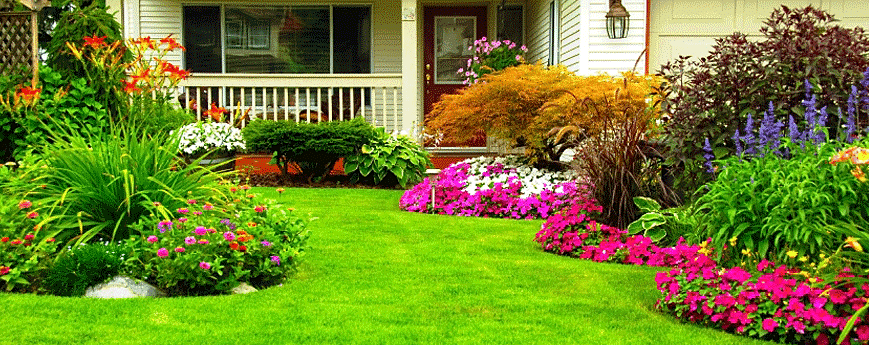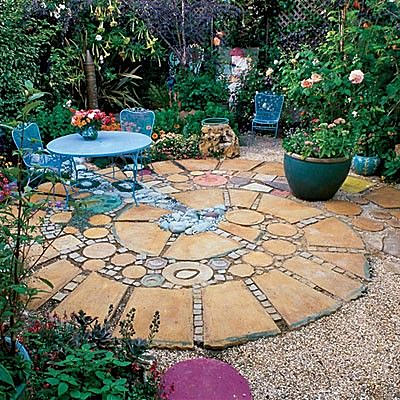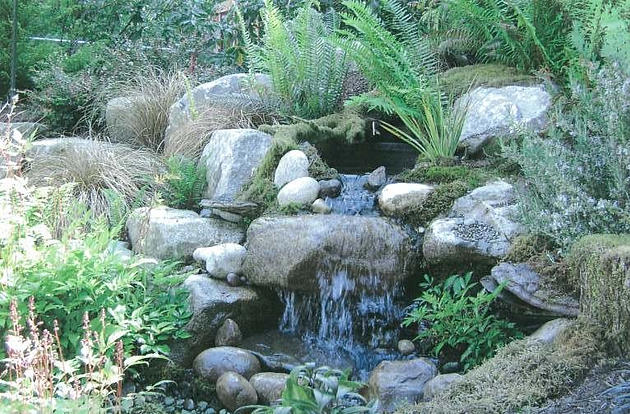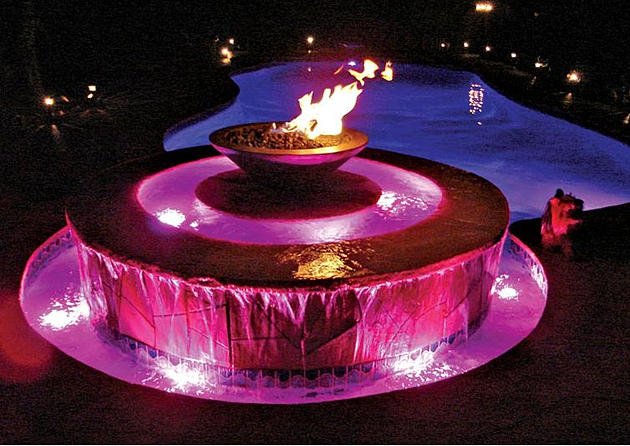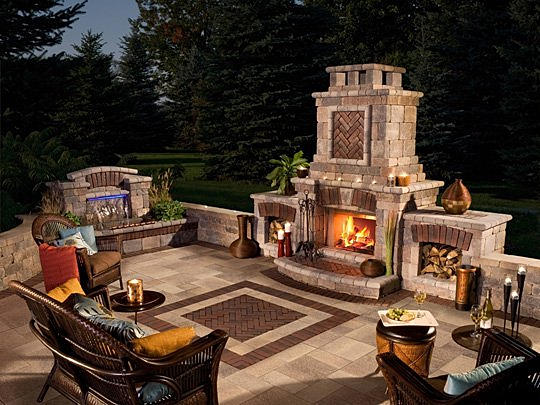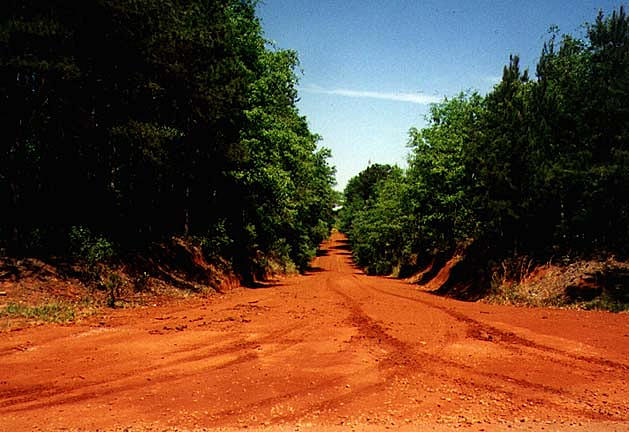
Thursday, November 20, 2014
GEORGIA RED CLAY, KNOW YOUR DIRT!

If you grew up in the Atlanta metro, you know all too well what that a pain it is to work with Georgia Red Clay. It's heavy, clumps together, stains your clothes, produces sub-optimal growth, and is generally a pain in the neck. But what is it? What are the most effective ways to landscape in this muck? How can you grow a row of stunning red nandinas in a bed of raunchy red clay?
WINTER COLOR
In this Meditteranean garden, the homeowners had a tight space to work with (their door is less than 25 feet from the curb!). The designers of this space maximized its potential by using iconic granite boulders which anchor the viewer's eyes to the ground, immediately grabbing visitors' attention. The granite works well with the stonework on the owner's home, providing architectural continuity. While so much stone might make a rigid design elsewhere, the elegant placement of Italian Cyprus (Cupressus sempervirens) softens the corners of this house, while the Yellow-twig dogwood (Cornus stolonifera (sericea) 'Flaviramea') provides excellent fall and winter color which are amplified, and produce striking effects during winter. Most people consider the space adjacent to the curb lost land, only to be used for grass lawns. These homeowners made a bold move that paid off when extending their low maintenance bed ofPhormium tenax and Heather Erica's all the way to the curb.
CHECK OUT OUR OTHER PAGES FOR MORE: WEBSITE, HOMEADVISOR, THUMBTACK, GOOGLE+ BUSINESS, FACEBOOK, TWITTER,YOUTUBE, GOOGLE+
10 TRICKS FOR A LOW-IMPACT LANDSCAPE
Modern landscaping includes tons of options that have very little concern for the environment. Water usage and fertilization of imported tropical plants or even just a tough to manage landscape can contribute unnecessary waste of scarce resources. If you're an eco-conscious homeowner that doesn't want to sacrifice curb appeal for warm and fuzzies, these 10 tricks are just what you need!
- Build a border. Plant a bed of "thirsty" plants along pathways, curbs, and other hardscapes. By building these beds you will retain more water in your lawn, reduce topsoil erosion, and soften those hard edges adding to the aesthetic appeal of your landscape.
- Start smart. Before you start planting anything, consider where water will naturally flow or pool on your property. Planting thirsty plants in natural depressions is a quick way to save on watering, since gravity will do most of the work for you.
- Use pots or planters. If you plan on planting tropical specimens that require frequent watering, consider using large pots, lined flower beds, or other contained growing areas. These containers trap far more moisture than open topsoil, and can often add depth to your garden area. Even when planting drought tolerant specimens, contained growing areas will lower your environmental footprint.
- Carve the lawn. Grass requires a significant amount of water every day just to survive. By sculpting your landscape to include hardscaped patio areas or perhaps a zen garden you can massively reduce its water requirement.
- Go with gravel. When installing paths, patios, or other outdoor structures that require sturdy walking surfaces, consider using gravel, or flagstone set in sand. A permeable surface will allow excess rainwater to be absorbed into the soil beneath instead of washed out into the street to be contaminated with debris and pollution.
- Desert dreams. Choosing to build a cacti garden, or arid landscape can save you massive amounts of time in maintenance, and permanently eliminate watering the lawn from your honey-do list. Plus, with it being such an uncommon choice in the Atlanta metro, anyone with the confidence to go with a desert themed landscape here is sure to turn heads.
- Stop-loss with Moss. If you still want the green grass aesthetic but are environmentally conscious, cultivating moss as groundcover is the way to go. Moss is drought tolerant once it's established, has no negative impact on soil, and churns out oxygen far faster than grass. Throw a few boulders in your yard, maybe a flagstone path, and moss groundcover and you'll have a low maintenance, low-impact landscape with a fairytale look.
- Mediterranean motiffe. The Mediterranean climate naturally produces drought tolerant plants. If the subdued colors of a Mediterranean garden don't appeal to you, try brightening it up with lavender or give it rich borders with a few Ilex crenata.
- Mulch Mulch Mulch! Covering your planting areas with 2 to 3 inches of quality mulch will not only discourage weeds from intruding into your beds and protect your plants, but it also significantly slows evaporation. By slowing water loss, your plants will have more time to absorb the moisture that's naturally deposited by rain and humidity, reducing your need to water.
- Mycorrhizal fungi. Mycorrhizal fungi grow on and between the roots of plants, enhancing their ability to absorb water and nutrients from the surrounding soil. Mycorrhizal deficient topsoil puts unnecessary stress on plants and allows valuable water and nutrients to seep deeper into the ground, beyond the reach of your plants' roots. You can buy mycorrhizal fungi spores at most nurseries and landscape supply retailers.
Check out our other pages to learn more and review our ratings!
ESCAPE THE METRO WITH A MEDITATION GARDEN
With long commutes being a way of life here in the Atlanta metro, having a serene place at home is a great way to reduce stress. The evening commute after being late on those darn TPS reports and finding out someone stole your stapler (again) is certainly no good for your blood pressure. But what if you could escape into a secluded oasis with trickling water, a sense of balance, and inspirational structure?
You don't have to be a Buddhist monk to appreciate a meditation garden. In fact, a meditation garden can be made in any landscape style of your choosing! Japanese, contemporary, english, cottage, colonial...absolutely anything. Some styles do lend themselves more naturally to creating meditation gardens, but they will all produce wonderful results with enough consideration given to these key elements:
Isolation. In our suburbs, naturally isolated garden areas are few and far between, so if you plan on creating your personal space at home, be ready for some work. There are several ways to isolate a garden space effectively from the sounds and sights of nearby roads or busy neighbors. If you don't want to build a fence or berm, tall hedges, bamboo groves, and dwarf trees make excellent barriers. Ultimately, anything that produces a clear sense of separateness can serve as a barrier to isolate your meditation garden from the rest of the world.
Unity of Design. The design of any pleasing landscape ought to include some unifying theme or style, but this is especially important when creating a meditation garden. This is a space where you should feel focussed and at ease. A haphazard design can cause feelings of unease, or other distractions that would disrupt anyone's alone time.
Sensitive Surfaces. Consider what surfaces in a meditation garden that you will find yourself walking, sitting, or laying on. Do you want them to be hard or soft? Silent (like mossy stone), loud (like gravel) or somewhere in between (like sand)? Also, think about the temperature these surfaces will reach during hot days. Any surface you use will have a unique feel that needs to be comfortable to you. Don't allow yourself to be constrained by the style of garden you've chosen either. With the right amount of creativity you can bring almost any medium into the construction of your garden.
Grand Entrance. The central element of your meditation garden should be the first thing you see when you enter this space, whether it's a Japanese Maple, a bubbling waterfall, or a raked sand box. Positioning this powerful imagery directly in front of the entrance will amplify the sensation of entering a new and separate space, allowing you to relax more quickly.
Make it Easy. Your meditation garden should be a place reserved for quiet reflection, not gruelling toil. If you create a high maintenance space you will find yourself working in it as often as enjoying it. A few special plant specimens (or even none at all) can prevent you from associating this space with weekend labor, preserving the tranquility you desire.
CHECK OUT OUR RATINGS AND REVIEWS WEBSITE HOMEADVISOR THUMBTACK FACEBOOK TWITTER YOUTUBE GOOGLE+
SAVE MONEY BY RE-PURPOSE LANDSCAPE PLANNING
The costs involved in a serious landscape overhaul can be prohibitively high for many home owners. We see landscapes every day dire states of disrepair with bleak prospects for improvement simply because of lack of budget and intention. Many of these landscapes are just a creative puzzle that needs be figured out.
In many cases working with nature is absolutely the cheapest way to go, and the one with the greatest potential for permanancy. Many times we wrestle with nature instead of simply learning from what it is so clearly telling us. The tightest budget landscape is the one you see all around you, the one that is provided free of charge, forests of green fauna, Rolling grasses on the tundra, Natural ground cover growing to the edge of a country road, or even the aquatic plants on the edge of a slow meandering stream. These cases seemingly extreme are very visible and all around you almost in every environment, if you begin to listen nature talks and reveals her beautiful life sustaining secret that is organic and connected to the real world we all live in.
We need remember that in our search for economic ease by finding the cheapest way out nature shows us a clear path of its natural solutions to pre-existing environmental site conditions. The rules of succession and survival are clear and simple. If we simple follow a few basic steps.
#1 NEVER GO AGAINST NATURE! when trying to save money in the long run NATURE WINS! "quick easy cheap human solutions equal long term gradual environmental succession" its simple nature is continually moving, growing and flowing its forces at work are great! EROSION, WEATHER EXTREMES, OXIDATION, ENVIRONMENTAL SUCCESSION, ANDGRAVITY these are only a few to mention but many are the radical foces of nature that seek to overcome the temperal solutions of a quick easy fix.
#2 LET YOUR DECISION BE SUSTAINABLE and based on natural solutions working with the environment instead of "cheap Mindedness and the constant shop for the cheaper material or Landscaper working at cost" There is a better way, find within the project to actually work with nature, allow the natural presence of nature to ebb and flow freely between the hard angled approach of imprinting our ownership on the environment. Together with nature turn cheap into elegant by not overpowering the most beautiful free elements all around us. Harness the full power of nature by creating with intention from and with what is naturally provided.
#3 BE WILLING TO RE-USE, RE-SOUCE, RE-CYCLE, RE-PURPOSE every living and non living Part of your landscape including Sod, plants, roots, risomes, clippings, leaf Waste, dirt no matter condition, Trees, Cut limbs, broken terra cotta pottery, Wood chips, old rotten garden timbers, wood, bricks, stones blocks, even old newspaper and onamental hay stacks left over from thanksgiving on the front porch. Whether your recycling into the compost or building up bed structure with organic waste you are definitely working well with nature to what extent is soley up to you. Allow yourself time to gather surplus resource however dont dilly daly to long neighbors might complain. Now its time to work up a re-purpose plan whether by yourself or a credible landscape proffessional designer. Remember scavenging from nature only cost your time and is a very relaxing medative chore.
A Radical RE-Scape Here is a real life example of a re-purpose landscape. The photo above was a joint endeaveor by a local local landscape professional and a homeowner it is a perfect example of the urban landscape design turned ecological and budget friendly through these basic concepts. In the picture above assembled in an artistic and intentional way you can find toadstools, moss. ferns, rocks, logs and even stumps. Swift but carefull they were gathered with the intent to reuse them before the tracks of an unforgiving bobcat could grind them into organic fill. Now repurposed as the main natural elements of a small waterfeature each and every detail clearly can be seen in this elegant but natural woodland landscape. This project holds testament to the true value of planning with intention, so next time your in your backyard dreaming about the future, take time and really look around at the natural resources in the present if anything you will begin to realize some resources you already have. I really hope you enjoyed this time please share your re-purpose story I would love to hear yours .
FREE RE-Scape Consultation!
Check out our other pages WEBSITE, HOMEADVISOR, THUMBTACK, FACEBOOK YOUTUBE TWITTER GOOGLE+
Outdoor Kitchens
These kinds of kitchens have been around for about a million years, literally, ever since thehumanoids first learned how to cook with fire. Let us help you bring your kitchen back to its natural place! If you are a master in the kitchen, a fully equiped outdoor kitchen might be an excellent option for you. Do you love to bbq with family and friends? Well, maybe a grill islandalong with some storage compartments would best suit your needs. Or do you prefer to bake? Perhaps an authentic pizza oven sparks your interest? There are many benefits this home addition can provide. If your yard isn't level sometimes an outdoor kitchen can be built at a medium level to combine or connect spaces on your grounds. Is healthy living and well-being a concern of yours? Creating a garden that is easily within reach and at your disposal filled with fresh vegetables, fruits, and herbs would be a grand idea. This addition could also be a brilliant way to increase your property value. It is a great investment that can potentially have financial gain if you were to sell your home. Whatever the case may be you can turn your backyard into a party pad, family gathering area, or a romantic enclave. The choice is yours! An outdoor kitchen is an exceptional addition to any backyard. Schedule for a free consultation with the Landscape Dr.
Outdoor Fireplaces and Fire Features
Adding an outdoor fireplace, fire pit, fire pot, fire ring, or fire feature is an exceptional way to extend the amount of months you can enjoy outside. These landscape additions are a great way to provide entertainment and bring the party outdoors. Keep your family and friends warm and cozy as you socialize and bond. If you are not into social gatherings you can use a fire to set a romantic tone for stargazing with a loved one. Or create an area for relaxation or meditation. Fire pits are a quick easy installation that radiates warmth and excitement. There are also Recessed Fire Pits that provide a sitting area and an open flame that can be used to roast hot dogs, marshmallows, and kabobs. Fire/Water pots (for manual key valve ignitions) combining these elements are as easy as the turn of a key valve. You can incorporate these in various parts of your landscape by themselves or even in swimming pools, jacuzzi, waterfalls, ponds, and fountains. Fire/Water pots (for spark ignition and remote control ignition) water surrounds the fire which is safely self contained in a dry chamber. You can add color rock to these two types of pots as well as fire pits for a nice pop. Adding an outdoor fireplace is a marvelous way to add ambiance to your home. Have the hottest yard in the neighborhood, literally! Although, don't forget when picking your fireplace or fire feature that you match it to the style of your home. This is an intelligent investment and a superb way to increase your property value.
Call the Dr today to get some FREE ideas 404-205-9335/770-299-1656
WEBSITE, HOMEADVISOR THUMBTACK FACEBOOK TWITTER YOUTUBE GOOGLE+ .
Why Winter May Be The Best Time For BIG Landscape Projects
When it comes to landscaping, most people think about lush green lawns, full color gardens in bloom, and warm sunny days. During the winter months, when trees are bare and gardens bleak, the landscaping industry gears down to a creeping pace. Some companies even shut-down operations altogether. So why on Earth would this be a good time for you to work on your property?!
The natural ebb of the landscaping industry during winter months can prove advantageous to the savvy home owner in several ways. With the right planning you can find yourself with higher quality improvements, huge savings on professional help, and outdoor living areas complete in time for spring. We're not talking about planting flowerbedshere (of course the cold weather will freeze out delicate specimens). This is the right time for big projects. Grading, demolition of unwanted growth, tree removal, retaining wall construction, installing paths or patios. The sort of projects that are built to last, and that add real value to your property.
It's no secret that there is a low demand for landscaping services during winter. Because of the low demand, most landscape service providers have far more flexible schedules. This means they won't be rushing to finish project after project, possibly cutting corners to complete their work for you and move on to another home. If you start a large winter project that requires professional help to complete, you can be confident that they will be able to spend more time and more resources on the details of your project without the distractions that warmer weather will bring them. This isn't to say landscapers won't give you a quality product during the summer, only that then they will not have nearly as much time to spend with you to learn exactly what your vision is and how to bring it to life.
With low demand comes low price. Your macro-economics professor wasn't lying. The landscaping industry is very unpredictable when it comes to the cost of work and materials. What you pay will be entirely dependent upon the company you hire and how much they mark-up their costs, not any larger market trends. Large, corporate companies will generally have more stable prices throughout the year because they can rest on their income generated through lawn maintenance contracts. Small, local companies are forced to under-cut the competition at this time of year unless they have supplemental income through material distribution or diverse maintenance accounts. The best winter deals will always come from local companies that specialize in landscape design and installation. These are the companies that will be the hungriest for work, and will be willing to take jobs at minimal rates (some may even go low enough as to only cover costs and overhead). Because these small companies have such a narrow customer base, they are far more succeptible to damages from negative reviews. So not only will they work with you on a tight budget, they'll do so with an eye to perfection.
If you're living in Tuxedo Park or have a seven figure home value, finding the cheapest deal probably isn't much of a motivator. Even if that's the case, winter is STILL the best time for these projects! The reason for this is simple: why waste warm weather working on your landscape? Nobody wants to step outside in April with the smell of spring in the air and sound of bobcats, powertools, and installation crews toiling rumbling the planks of their deck. Waiting until the good weather comes to improve your outdoor living areas is like waiting until after your wedding day to order your cake. It's already too late to fully appreciate what you've got!
Check out our other pages to learn more and review our ratings: LANDSCAPEDR, HOMEADVISOR THUMBTACK FACEBOOK YOUTUBETWITTER GOOGLE+
Subscribe to:
Comments (Atom)

